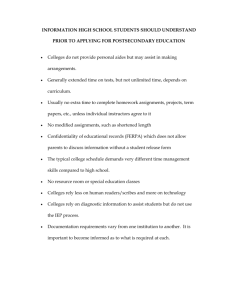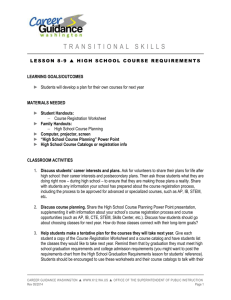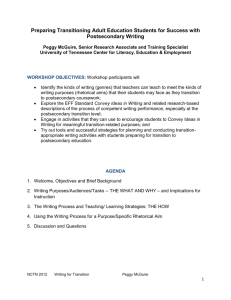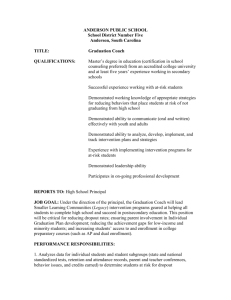PROGRAM OF STUDY WORK SHEET INSTRUCTIONS A Program
advertisement
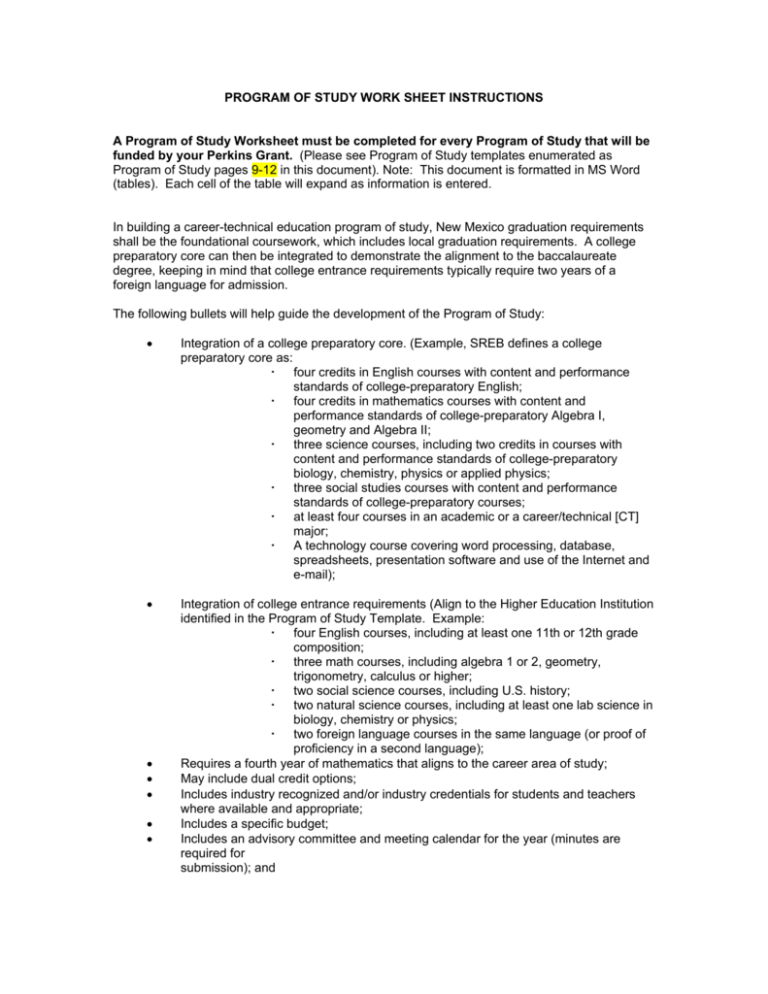
PROGRAM OF STUDY WORK SHEET INSTRUCTIONS A Program of Study Worksheet must be completed for every Program of Study that will be funded by your Perkins Grant. (Please see Program of Study templates enumerated as Program of Study pages 9-12 in this document). Note: This document is formatted in MS Word (tables). Each cell of the table will expand as information is entered. In building a career-technical education program of study, New Mexico graduation requirements shall be the foundational coursework, which includes local graduation requirements. A college preparatory core can then be integrated to demonstrate the alignment to the baccalaureate degree, keeping in mind that college entrance requirements typically require two years of a foreign language for admission. The following bullets will help guide the development of the Program of Study: • Integration of a college preparatory core. (Example, SREB defines a college preparatory core as: four credits in English courses with content and performance standards of college-preparatory English; four credits in mathematics courses with content and performance standards of college-preparatory Algebra I, geometry and Algebra II; three science courses, including two credits in courses with content and performance standards of college-preparatory biology, chemistry, physics or applied physics; three social studies courses with content and performance standards of college-preparatory courses; at least four courses in an academic or a career/technical [CT] major; A technology course covering word processing, database, spreadsheets, presentation software and use of the Internet and e-mail); • Integration of college entrance requirements (Align to the Higher Education Institution identified in the Program of Study Template. Example: four English courses, including at least one 11th or 12th grade composition; three math courses, including algebra 1 or 2, geometry, trigonometry, calculus or higher; two social science courses, including U.S. history; two natural science courses, including at least one lab science in biology, chemistry or physics; two foreign language courses in the same language (or proof of proficiency in a second language); Requires a fourth year of mathematics that aligns to the career area of study; May include dual credit options; Includes industry recognized and/or industry credentials for students and teachers where available and appropriate; Includes a specific budget; Includes an advisory committee and meeting calendar for the year (minutes are required for submission); and • • • • • • Identifies the specific Career-Technical Student Organization with which to affiliate at the secondary level. Each item number below corresponds to the numbering scheme in the Program of Study Form which follows. Page 1 - Header section Click twice in the Header Section and insert the following information in the numbered areas. This information will carry forward to the header sections on the succeeding pages, so it is not necessary to re-enter it on each page (except for the Addendum POS). 1. Insert name of school or institution. (e.g. Success High School; Achievement Community College) 2. Indicate the appropriate State level Career Cluster for the Program. Select from the following list: 1) Arts & Entertainment 2) Business Services 3) Communications & Information 4) Energy & Environmental Technologies 5) Engineering, Construction, Manufacturing & Agriculture 6) Health & Biosciences 7) Hospitality & Tourism See Appendix G for Crosswalk to assist you in responding to number 3 below. More information about the State level Career Cluster initiative can be found at www.workinnewmexico.gov. 3. Indicate the matching National Career Cluster (one of the 16 recognized Clusters – see Appendix B for Listing) 4. Indicate the appropriate Pathway as it aligns to the National Career Cluster Framework (e.g. Management). To see a listing of the pathway titles go to www.careerclusters.org/16clusters.htm, then click on the PDF or word document next to the heading Resources. 5. Indicate the specific Associate Degree Plan or Certificate option at the Postsecondary level to which the Program of Study aligns. Program of Study and Budget Summary Sections 6. In an effort to demonstrate the beginning of an alignment to the four-year institution as required in the Federal Act, delineate the name of the four-year institution to which the program of study aligns. 7. In an effort to demonstrate the alignment to the four-year degree (bachelor degree), delineate the title of the bachelor degree to which the program of study can/will lead. While some AAS degrees are terminal, align the program of study to a related bachelor degree option. Labor Market Information: 8. Use the NM Department of Labor web site (http://laser.state.nm.us/) to determine the requested information: a. Number of jobs projected to exist in occupations for which this program prepares students; b. The projected entry salary for a worker in this occupation; c. The estimated median salary for a worker in this occupation; and d. The estimated salary for an experienced worker in this occupation. (Note: Programs of Study for pathways/occupations that demonstrate a negative or insufficient growth and/or less than twice the minimum wage in the entry salary will not be considered for funding.) For high-demand jobs that do not meet the minimum entry salary requirement of $13.10 per hour, complete the table and respond to question 4 on the Addendum Program of Study. 9. Identify the student organization with which to affiliate at the secondary level. The career-technical education student organizations recognized by the State of New Mexico are identified on the Program of Study form. Postsecondary institutions are welcome to identify the student organization with which to affiliate at the postsecondary level if applicable; however, it is not required. 10. Provide the names of local industry partners providing support. Support may come by way of providing technical assistance on instruction or laboratory environments, review of curriculum, evaluation of the program, sponsorships for fees of industry recognized certifications, financial support, etc. (e.g. Public Service Co. of NM) 11. Identify the industry recognized credentials and/or certification(s) offered to students through the program of study (e.g. Oracle Certification). The credential/certification does not dictate the curriculum; the credential/certification is the result of the sequential education/training program. Industry recognized credentials and/or certifications are only required if they are available and appropriate for the pathway. Note, there is a core indicator of performance related to the credential, therefore, it is strongly encouraged that all institutions seek to offer a relevant/related industry credential if possible. 12. List the names of the members of the Advisory Committee for the program of study and their industry or business affiliation, (e.g. James Day, HR Director of First State Bank). Educators at the secondary and postsecondary level are to be listed as such. Therefore, an adequate makeup of advisory members is necessary to inform instruction, communicate business and industry needs, etc. The advisory members may be different than those listed in the local industry partnership list as specified in number 10 above. Advisory committees must meet at a minimum of twice during the school year. At a minimum, the advisory committee shall function at the cluster level. Secondary and postsecondary institutions are encouraged to merge the advisory committees if possible and practical. Page 2 – Secondary Program of Study Information 13. Identify all courses that meet New Mexico Graduation Requirements. Include the corresponding STARS course codes. All courses listed on this section shall be in red font. BIE schools shall use local course catalogue codes in lieu of STARS course codes. Minimum Graduation Requirements (Public School Code 22-13-1.1) are as follows: For students entering the ninth grade beginning in the 2009-2010 school year, the requirements for successful completion of the New Mexico diploma of excellence shall be: A minimum of twenty-four units aligned to the state academic content and performance standards shall be required to earn a New Mexico diploma of excellence. These units shall be as follows: i. Four units in English, with major emphasis on grammar, nonfiction writing and literature; ii. Four units in mathematics, of which one shall be the equivalent to or higher than the level of algebra 2, unless the parent submitted written, signed permission for the student to complete a lesser mathematics unit; iii. Three units in science, two of which shall have a laboratory component; iv. Three and one-half units in social science, which shall include United States history and geography, world history and geography and government and economics, and one-half unit of New Mexico history; v. One unit in physical education; vi. One unit in one of the following: a. a career cluster course, b. workplace readiness, c. or a language other than English; and vii. Seven and one-half elective units that meet department content and performance standards. Student service learning shall be offered as an elective. Note: Final examinations shall be administered to all students in all classes offered for credit. Additionally, at least one of the units for graduation shall be earned as an advanced placement or honors course, dual-credit course offered in cooperation with an institution of higher education or a distance learning course. For students entering ninth grade in 2005-2006 and after (fifteen and one-half specified and seven and one-half elective) i. Four units of English, with major emphasis on grammar and literature; ii. Three units in mathematics, at least one of which is equivalent to the algebra 1 level or higher; iii. Three units in science, one of which shall have a laboratory component; iv. Three units in social science, which shall include United States history and geography, world history and geography and government and economics; v. One unit in physical education; vi. One unit in communication skills or business education, with a major emphasis on writing and speaking and that may include a language other than English; vii. One-half unit in New Mexico history for students entering the ninth grade beginning in the 2005-06 school year; and viii. Seven and one-half elective units for students entering the ninth grade in the 2005-06 school year that meet public education content and performance standards. Student service learning shall be offered as an elective. Note: While graduation requirements for students who entered high school prior to the 2005-2006 school year are different than what is listed above, the program of study shall be designed to accommodate the requirements of freshmen students entering high school in 2005-2006. Accommodation for graduation requirements for students who entered high school prior to 2005-2006 can be made in the student’s Next Step Plan. Graduation requirements for those students who entered high school prior to school year 2005-2006 are listed below for your information only. For students entering prior to 2005-06 (14 specified, 9 elective) i. Four units of English, with major emphasis on grammar and literature; ii. Three units in mathematics, at least one of which is equivalent to the algebra 1 level or higher; iii. Two units in science, one of which shall have a laboratory component; iv. Three units of social science, which shall include United States history and geography; world history and geography and government and economics; v. One unit in physical education or other physical activity; vi. One unit in communication skills or business education, with a major emphasis on writing and speaking and that may include a language other than English; vii. Nine elective units that meet the state board content and performance standards. Student service learning shall be offered as an elective. BIE and BIE Grant/Contract schools may use this section to delineate the tribal course requirements for graduation/completion. 14. Enter the course name and STARS course code for each course included in this Program of Study that is an additional local district required course or tribal required course if BIE. BIE schools shall use local course catalogue codes in lieu of STARS course codes. These courses shall be recorded in black font except for dual credit courses which shall be recorded in green font. 15. Enter the course name and STARS course codes for each course included in this Program of Study that is a career requirement or elective or college entrance requirement i.e. accounting I, foreign language, etc. Institutions may record “foreign language I”, “foreign language II” rather than “Spanish I” etc. The foreign language requirement must be two years of instruction in the same language. Although it is likely for 2-year institutions to not require the foreign language, it may be a requirement for admission to a 4-year institution – and the new Act supports the partnerships among secondary schools, postsecondary institutions, and baccalaureate degree granting institutions. Native American languages and American Sign Language (ASL) are acceptable foreign languages. Color code courses that are dual credit in green font. 16. Identify any extra help strategies offered to support this program. Extra help strategies at the secondary level could include Reading Lab/Accelerated Reader, Math Tutoring Lab, etc. At the Postsecondary level, it may be aspects of the student services office/system. In the notes section below Item 16 on the program of study, include any information that will assist one in reading the document. For example, note the type of schedule being offered in the secondary component, i.e. block schedule, AB schedule, 7 period day, etc. Page 3 – Post-Secondary Program of Study Information 17. Enter the core courses, as aligned between the postsecondary institutions, (including summer if applicable). Refer to the HED website for transfer module information at: http://hed.state.nm.us/content.asp?CustComKey=193242&CategoryKey=287396&Web FileKey=287402&pn=webfilesview&DomName=hed.state.nm.us 18. Enter the course requirements in the general education core for this degree plan of study. 19. Enter the required courses for the certificate or associate degree. 20. Enter the additional course requirements unique to this institution. 21. Enter applicable work based opportunities and/or community service options aligned to pathway certification and or two-year certificate or degree. 22. List the career enhancement options offered by this institution in this program of study. This shall include the identification of Industry-recognized Credentials/Certifications available to students at any time during the pathway. Page 4 – Addendum Program of Study 23. This question is for Secondary institutions only. Reflect on how the implementation of this program of study has an impact on student academic achievement. Examples may include the fourth year of math, the contextual learning environment, the alignment to EPSS goals and school wide strategies, aligned professional development, etc. BIE institutions shall discuss how the program of study aligns to the 1114 plan. 24. This question is for Postsecondary institutions only. If the institution in not currently a partner in the WIA system, then describe the actions that the institution will deploy to become an active partner in the WIA system. Elaborate about the connection between the program of study and the One-Stop-Centers. 25. Secondary and postsecondary institutions must respond to this question. The names and certifications being sought through this funding shall be included in the response to this question. Inclusion of anticipated date of completion of the certification is also necessary. Professional development shall align to Required Use 5 of the Perkins Act. 26. If the program of study does not meet the $13.10 (beginning July 24, 2008) minimum entry wage requirement, but is a high-demand job, describe how the proposed wage meets the criteria of self-sufficiency. The definition of self-sufficiency can be found in Appendix E.

